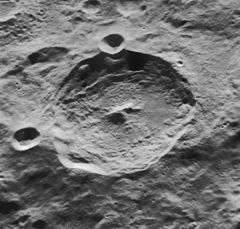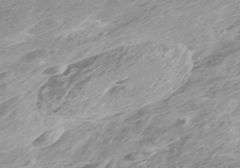Plutarch (crater)
Plutarch is a lunar impact crater that lies near the north-northeastern limb of the Moon, just to the south of the irregular crater Seneca. To the southeast is the flooded crater Cannon. The proximity of this crater to the limb causes it to appear foreshortened when viewed from the Earth, but it is actually a circular formation.
 Oblique Lunar Orbiter 4 image | |
| Coordinates | 24.1°N 79.0°E |
|---|---|
| Diameter | 68 km |
| Depth | 2.8 km |
| Colongitude | 282° at sunrise |
| Eponym | Plutarch |

This crater has a well-defined rim edge that is only slightly eroded. A small crater intrudes slightly into the southwestern rim, and another small crater lies near the south-southeastern rim. The inner wall is unusually wide in the southern half of the crater, with the narrowest section along the northern rim. There is some slumping and terraces formed along the inner sides, and a notable central peak near the midpoint of the interior floor.
Satellite craters
By convention these features are identified on lunar maps by placing the letter on the side of the crater midpoint that is closest to Plutarch.
| Plutarch | Latitude | Longitude | Diameter |
|---|---|---|---|
| C | 23.1° N | 71.0° E | 11 km |
| D | 24.3° N | 75.7° E | 15 km |
| F | 23.5° N | 73.5° E | 12 km |
| G | 23.0° N | 75.2° E | 11 km |
| H | 24.4° N | 72.7° E | 11 km |
| K | 25.1° N | 72.8° E | 11 km |
| L | 25.8° N | 71.6° E | 8 km |
| M | 23.8° N | 77.6° E | 11 km |
| N | 23.8° N | 77.1° E | 12 km |
References
- Andersson, L. E.; Whitaker, E. A. (1982). NASA Catalogue of Lunar Nomenclature. NASA RP-1097.CS1 maint: ref=harv (link)
- Blue, Jennifer (July 25, 2007). "Gazetteer of Planetary Nomenclature". USGS. Retrieved 2007-08-05.CS1 maint: ref=harv (link)
- Bussey, B.; Spudis, P. (2004). The Clementine Atlas of the Moon. New York: Cambridge University Press. ISBN 978-0-521-81528-4.CS1 maint: ref=harv (link)
- Cocks, Elijah E.; Cocks, Josiah C. (1995). Who's Who on the Moon: A Biographical Dictionary of Lunar Nomenclature. Tudor Publishers. ISBN 978-0-936389-27-1.CS1 maint: ref=harv (link)
- McDowell, Jonathan (July 15, 2007). "Lunar Nomenclature". Jonathan's Space Report. Retrieved 2007-10-24.CS1 maint: ref=harv (link)
- Menzel, D. H.; Minnaert, M.; Levin, B.; Dollfus, A.; Bell, B. (1971). "Report on Lunar Nomenclature by the Working Group of Commission 17 of the IAU". Space Science Reviews. 12 (2): 136–186. Bibcode:1971SSRv...12..136M. doi:10.1007/BF00171763.CS1 maint: ref=harv (link)
- Moore, Patrick (2001). On the Moon. Sterling Publishing Co. ISBN 978-0-304-35469-6.CS1 maint: ref=harv (link)
- Price, Fred W. (1988). The Moon Observer's Handbook. Cambridge University Press. ISBN 978-0-521-33500-3.CS1 maint: ref=harv (link)
- Rükl, Antonín (1990). Atlas of the Moon. Kalmbach Books. ISBN 978-0-913135-17-4.CS1 maint: ref=harv (link)
- Webb, Rev. T. W. (1962). Celestial Objects for Common Telescopes (6th revised ed.). Dover. ISBN 978-0-486-20917-3.CS1 maint: ref=harv (link)
- Whitaker, Ewen A. (1999). Mapping and Naming the Moon. Cambridge University Press. ISBN 978-0-521-62248-6.CS1 maint: ref=harv (link)
- Wlasuk, Peter T. (2000). Observing the Moon. Springer. ISBN 978-1-85233-193-1.CS1 maint: ref=harv (link)